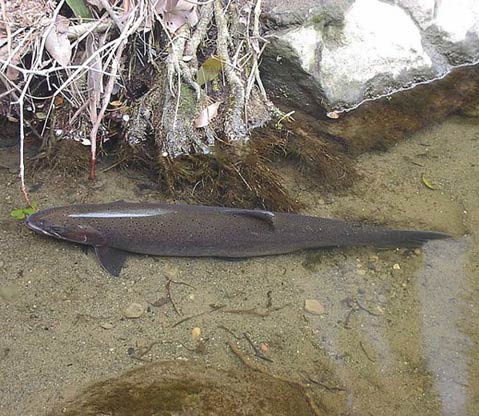Wooing Steelhead Back From Extinction
Restoration Plan Adopted from Santa Maria to San Diego

After 15 years of preparation, the National Marine Fisheries Services (NMFS) has finally issued its blueprint for bringing Southern California’s steelhead trout back from the brink of extinction. The plan covers all rivers and major creeks from Santa Maria to San Diego, and will cost an estimated $2.1 billion — over 100 years — when fully implemented. For the eight creeks of southern Santa Barbara County — from Jalama to Rincon — the estimated cost will be roughly $389 million. Nothing in the plan mandates such expenditures. Nor does the plan exert the raw force of government regulation. But it gives steelhead advocates a powerful new tool.
It provides a scientifically vetted, federally sanctioned road map for bringing the once bountiful fish back. Future developments that encroach upon steelhead habitat — or undermine restoration efforts — can be challenged with greater legal authority on those grounds under California’s Environmental Quality Act. Increasingly, decision makers will have to factor in the fish when making their decisions. And for agencies seeking funding to restore steelhead habitat, the plan will open many doors, said Mark Capelli of NMFS. “The steelhead will now have a seat at the table — a very official seat at the table — not a spot along the wall in the back,” he said.
Current steelhead populations throughout Southern California are estimated at 500. Fifty years ago, the number was closer to 50,000. During winter spawning runs, the Santa Ynez River was so engorged with steelhead that people caught them using pitchforks, and school officials excused truant students who skipped class to go fishing. But with the development of Bradbury Dam, the main stem of the Santa Ynez River short-circuited the life cycle of steelhead, blocking them from making their way up the channel to spawn and then back out again to sea. Closer to shore, the construction of Highway 101 and railroad tracks blocked many of the creeks running from the mountains to the sea. And as communities pumped their groundwater more aggressively, there was less surface water to maintain a sufficient summertime trickle to keep juvenile fish afloat.
If the steelhead nearly died from a thousand cuts, the report indicates they will have be restored by a thousand Band-Aids. The plan identifies specific strategies to make that happen, not to mention many of the partners whose participation will be needed. But even before the plan was adopted, many of the communities along the South Coast had begun embarking on major projects to help bring the steelhead back. New bridges have been built over Carpinteria Creek to the south, providing the fish a fresh shot upstream. Two new bridges have been built spanning Santa Barbara’s Mission Creek in the past two years, and fish passage — as well as flood control — was engineered into its design. Further up Mission Creek, the concrete culverts installed decades ago by Caltrans are being re-engineered to allow safe harbor for steelhead wending their way upstream.
The report does not envision a return to the “good old days” but to a point where fish populations can achieve biological viability, meaning they can weather the extreme hydraulic and temperature fluctuations that occur over a 100-year span. “That the fish have persisted despite our utter lack of concern and utter lack of protection is cause, I think, for optimism,” said Capelli. “We’ve turned the corner from not paying any attention to the fish to paying a lot of attention.”



